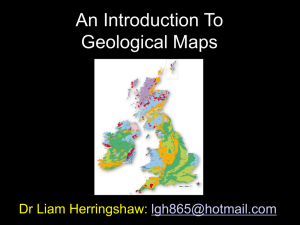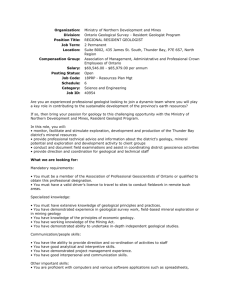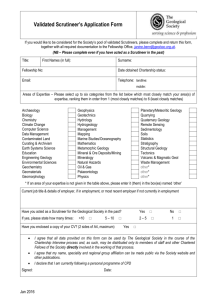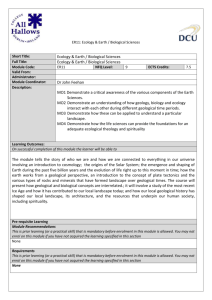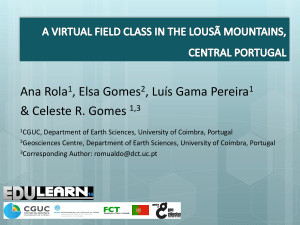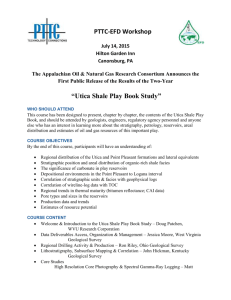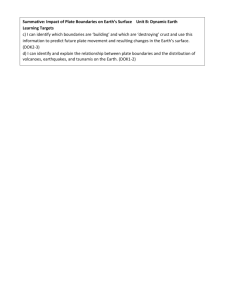Geological Periods - mnemonic - edel
advertisement
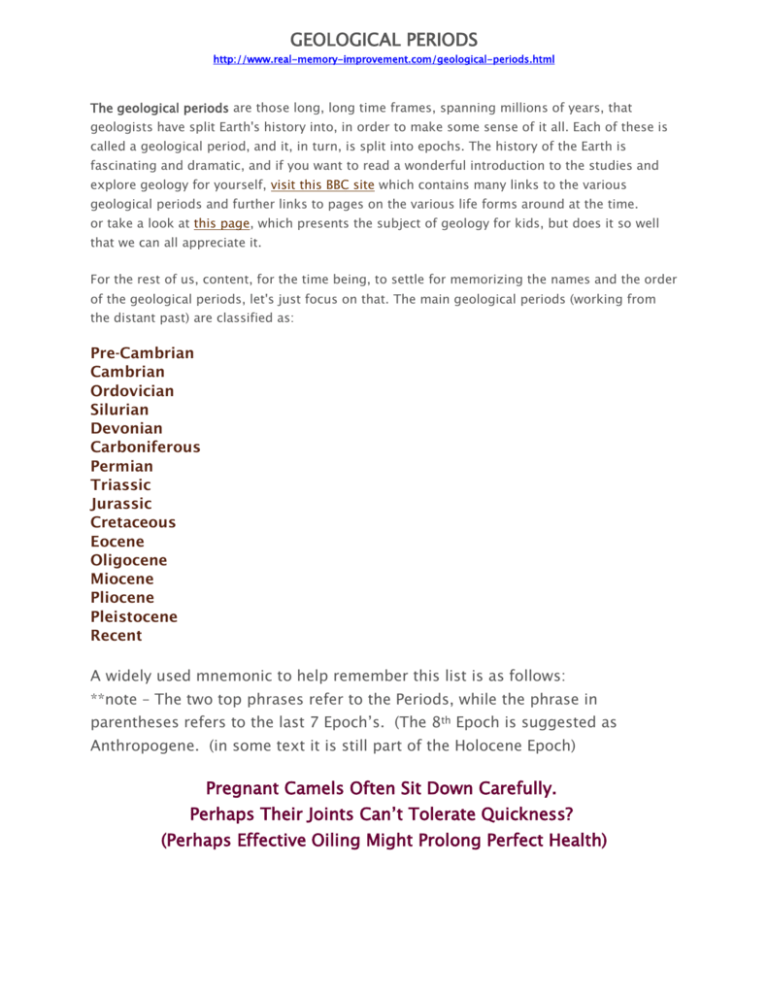
GEOLOGICAL PERIODS http://www.real-memory-improvement.com/geological-periods.html The geological periods are those long, long time frames, spanning millions of years, that geologists have split Earth's history into, in order to make some sense of it all. Each of these is called a geological period, and it, in turn, is split into epochs. The history of the Earth is fascinating and dramatic, and if you want to read a wonderful introduction to the studies and explore geology for yourself, visit this BBC site which contains many links to the various geological periods and further links to pages on the various life forms around at the time. or take a look at this page, which presents the subject of geology for kids, but does it so well that we can all appreciate it. For the rest of us, content, for the time being, to settle for memorizing the names and the order of the geological periods, let's just focus on that. The main geological periods (working from the distant past) are classified as: Pre-Cambrian Cambrian Ordovician Silurian Devonian Carboniferous Permian Triassic Jurassic Cretaceous Eocene Oligocene Miocene Pliocene Pleistocene Recent A widely used mnemonic to help remember this list is as follows: **note – The two top phrases refer to the Periods, while the phrase in parentheses refers to the last 7 Epoch’s. (The 8th Epoch is suggested as Anthropogene. (in some text it is still part of the Holocene Epoch) Pregnant Camels Often Sit Down Carefully. Perhaps Their Joints Can’t Tolerate Quickness? (Perhaps Effective Oiling Might Prolong Perfect Health) Now that's what I call a mnemonic! It's not hard to remember, it brings up vivid images, and it makes sense, in a sort of weird, humorous way. Spend a few minutes memorizing that mnemonic and you'll have made a good start in remembering the different periods of geological time, in order. And once you have that boxed off, you can go further if you choose to. You can learn more about what characterizes each geological period, what life forms were about at the time, and what geological or paleontological event brought about the change to the next period (since the geological periods are defined by the events, sometimes events of cataclysmic geology, that either started or ended them). This is just one example of how using a mnemonic can be a valuable stepping stone on the way to really learning a subject. The table below gives you some brief details of each of the geological periods. It indicates when certain life forms appeared and gives a very broad overview of the way life itself developed, in all its amazing diversity. This isn't a magic bullet to make learning an automatic process, but it certainly is a shortcut to getting a good grounding in a subject. It's also a perfect way to present geology for kids. Bear in mind that the geological periods from the Cambrian onwards cover only a fraction of Earth's history. The planet has been around for probably 4.5 billion years. The first life probably didn't evolve until 3.8 billion years ago, and consisted of single celled prokaryotic cells (the cells lacking both a nucleus and a membrane) such as bacteria. The kind of life forms that we are familiar with didn't begin to appear until about 570 million years ago. Human life, in comparison, has only existed for perhaps a couple of million years, a mere blip in the Earth's long and varied history - much, much less than one percent! An overview of the periods of geological time If you take a look at the table you can learn a lot in just few minutes. For example, Most of the Earth's history lies in the Pre-Cambrian Period (about 90%), stretching way back into the Earth's mostly lifeless era, when the only life consisted of tiny multi-celled organisms Life on Earth after the Pre-Cambrian Period (complex organisms at least) was mainly marine life and plants for about 130m years or so For another 150m years life abounded and developed in all imaginable forms, then most species became extinct For another 100-200m years dinosaurs were dominant, with mammals eventually starting to make an appearance Then, about 65m years ago, the dinosaurs and most other species were wiped out, possibly by an asteroid strike, and then, after the cataclysm, smaller animals, including mammals, slowly came into their own Over the last 50m years or so, monkeys, apes and hominids developed to the point where various species of humans eventually gained a foothold Homo sapiens (modern man) developed over the last 2m years or so Over the last 50-100,000 years or so homo sapiens developed the skills and techniques that allowed him to spread into every part of the world and make use of tools, farming and eventually living in a society rather than just as scattered individuals and families Obviously this is just my brief take on things, and I don't claim any great accuracy. But the thing is, it shows the kind of thinking that can start to make sense out of a brief list of details. And that list is of very limited use to you if you can't even remember it! That's where mnemonics come in, or any memorization method that works for you. An example of memory techniques in use So this is just an example of how you can really use your improved memory. Instead of grinding to a halt because the subject just seems too complex and too difficult to remember, you can at least make a start by using simple memory techniques. From there, who knows? Perhaps you'll go on to study geology, or paleontology, and be better prepared to handle it. You can, for instance (as shown above) use a simple mnemonic to get a handle on something as huge as the geological time scale, and from there you can move on, memorizing some basic facts about each of the respective geological periods. Working this way, and treating it as a bit of a memory game, you might find it a lot more fun and a lot easier and more useful than more traditional learning methods. Geological Periods Period Recent = Cenozoic Approx. Duration Characteristics, Events 10,000 years ago to the Larger mammals - humans present time Pleistocene 2 million years Pliocene 3 million years Mammals developing further, many of them (such as lemurs) very small to better cope with the harsh temperatures of the ice ages - apes, primates, Miocene 17 million hominids appear - cataclysm, possibly years caused by an asteroid strike in the Yucatan Peninsula, about 65m years Oligocene 13 million ago, wipes out most of the larger years dominant species of the time (inc. Eocene Cretaceous Jurassic Triassic Permian Carboniferous Devonian Silurian Ordovician Cambrian 22 million dinosaurs) years 80 million Dinosaurs and other reptiles dominant years - seed-bearing plants appear 54 million Flying reptiles (pterosaurs), larger years dinosaurs, earliest birds 51 million Crocodiles, turtles, early dinosaurs, first years mammals appear 48 million Large reptiles and amphibians - most years species become extinct 60 million Swampy forests - insects, amphibians, years reptiles, crustaceans, fishes 57 million Diversity in marine life and plants - first years trees - wingless insects 28 million First jawed fish - giant scorpions - years corals 45 million More diversity in marine life, Including years vertebrates - vascular plants 54 million years Invertebrate sea life Ended about Pre-Cambrian 542 million Formation of oceans, atmosphere and years ago. continents - bacteria - oxygen builds Covers about up - multi-celled organisms begin to 90% of the appear Earth's history Note: This is not an exhaustive list of characteristics of the geological periods, just a cut-down version suitable for grasping an overview of the subject, and for providing an exercise in memorization. It can be helpful though if you want to start to explore geology, or if you are presenting geology for kids to learn.
